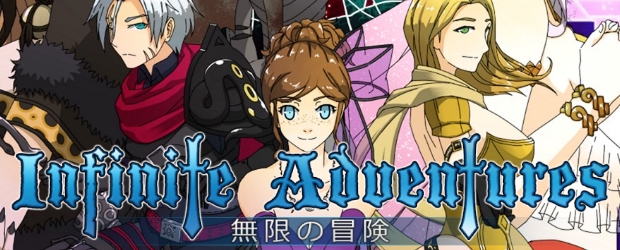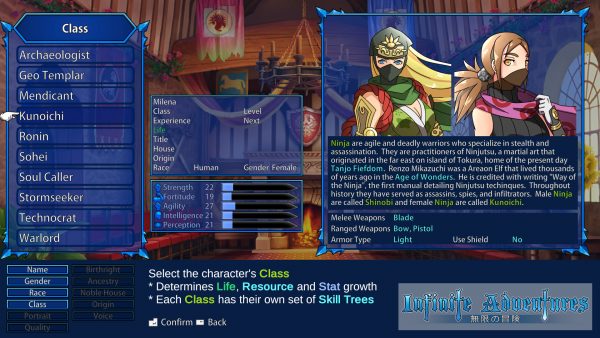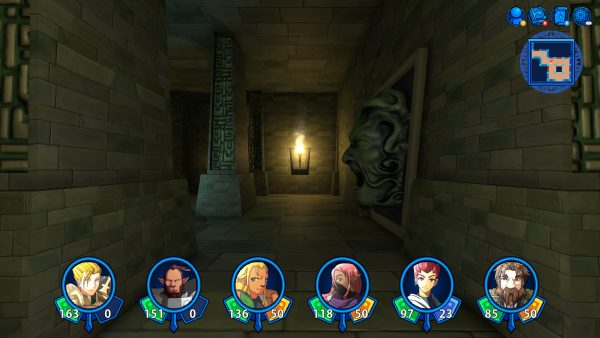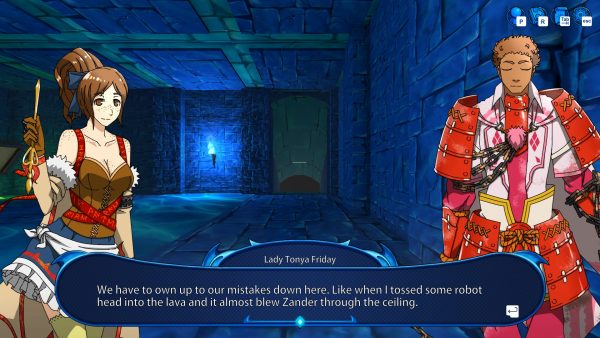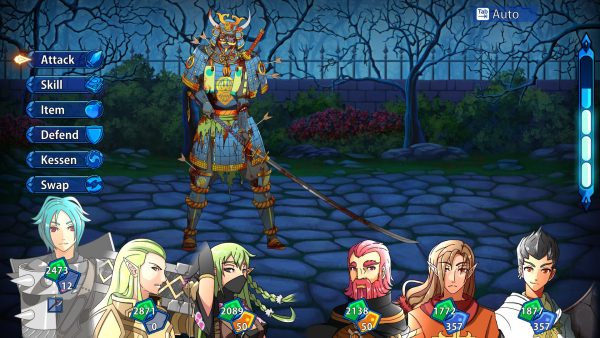Switch to: German
We’ve covered a surprising amount of dungeon crawlers over the past year, many of which have been excellent additions to what is a rather niche genre. Infinite Adventures is the latest DRPG to be released, being in the making for many years now. The final product after this long development time is a somewhat inconsistent game that, while still enjoyable, is hard to fully recommend.
Compared to the last few DRPGs we’ve covered, Infinite Adventures is a much more traditional dungeon crawler. No monster collecting or large party sizes here, though the game does try to add its own spin on the genre here and there. The main goal for you and your party of adventurers is to explore the ‘Infinite Labyrinth’, a place that is seemingly connected to a different world. You can either choose to create adventurers or pick from a few pre-made characters, though you will always have to design the main character.
Character creation isn’t overly complicated, but it does do a poor job of telling the player what each class actually does. Some classes like Mendicant a self explanatory, acting as the basic healer that you’ll find in most RPGs, but without looking for information outside the game it’s not obvious what a Geo Templar is supposed to do. A lot of the character creator choices focus on trying to set up Infinite Adventures’ world at the expense of actually useful gameplay information, though this is part of a larger problem that we’ll go into further detail later in the review.
Once your initial party setup is over, it’s time to explore the Infinite Labyrinth. Contrary to its name, there are actually a finite amount of floors (or stations as they’re known in-game) and any randomly generated areas are optional unlocks. The basic flow of the game is gearing up your party in town before making your way through the labyrinth until you reach a new floor or story event. Events in Infinite Adventures have a tendency to either take you back to town or require you to leave before you can progress further in the labyrinth. This becomes annoying on later floors, since you likely end up being sent back to town many times, leading to a lot of backtracking. There is the option to adjust the rate of enemy encounters – even turning them off entirely on lower difficulties – but it still becomes annoying having to go through an area again for no real reason.
The labyrinth itself is mostly a generic set of hallways and rooms, having little in the way of interesting gimmicks or designs. The most the game comes to spicing things up is the occasional simple block pushing puzzle or hidden passageway. Loot is quite sparse, usually being guarded by yokai, powerful enemies that are visible on the map. One set of floors started to become incredibly boring after running into an unnecessary amount of dead ends, and most of the labyrinth could have done with more interesting floor layouts. A few more puzzle types would have been a good idea too, as the block puzzles never become particularly difficult.
Battles are Infinite Adventures’ strong point, making up for the lacklustre dungeons. Between some interesting classes and the empower mechanic, battles are usually quick and generally pretty fun. Each class uses one of four resource types, from generic mana to rage which fills when dealing and receiving damage. This helps to make classes feel unique compared to other DRPGs and allows for some more creative party setups. The empower meter adds an extra layer of strategy, giving you the option to either buff skills or use powerful specials moves called ‘Kessens’ though the former is generally more useful. Having some sort of extra resource to manage during battles is something that many DRPGs seem to do nowadays, and it definitely helps add an extra layer of strategy to each encounter.
While battles may be the strongest part of the game, there are still a few issues when it comes to the way certain classes are designed. Many skill trees end up being near useless compared to others no matter what party composition you are using, and some classes end up being easily outclassed by others. This isn’t too big of a deal on the easier difficulty levels, but some more time could have been spent on class balancing. The aforementioned Kessens also feel rather weak later on in the game when you have access to better skills that benefit from being empowered.
This brings us to the one area in Infinite Adventures that really has little going for it: The story. For most dungeon crawler fans a lengthy story is less of a priority compared to interesting dungeons and combat, but games like Labyrinth of Refrain show that you can have all of that without sacrificing anything. It becomes apparent early on in Infinite Adventures that a lot of time has been spent designing the game’s world and lore, each choice in the character creator containing descriptions of places and important people. But, as with most of the way information is given to you during the game, its hard to care about any of the world with how quickly everything is introduced.
Characterisation suffers a lot from this need to give too much detail on unimportant things. Characters will often talk about the various lands they come from and people you’ll never meet and likely forgot about quickly. Their actually personalities and motivations end up being rather simplistic, and by the end of the story there were only a couple of characters that were actually interesting. Instead of trying to create a large world with a detailed backstory, they should have toned it down and instead focused on creating characters that the player will actually care about.
The problems with the story are made worse by Infinite Adventures’ varying visuals and poor voice acting. The 2D backgrounds are by far the best looking part of the game, but these don’t mesh with the character and enemy art. Again, wildly varying art styles are nothing new when it comes to DRPGs, but here it just makes the mediocre art look even worse. The 3D environments don’t fare much better, many of which look bland and lifeless. It’s the voice acting that delivers the final blow to an already poor story though. The amount of voice acting is at least worth mentioning, as every single line of dialogue is voiced, but that ends up being to the game’s detriment. For the purposes of this review we declined from turning off voices – a welcome feature – but many scenes would have had a little more impact without the amateurish voice acting.
We mentioned at the start of this review that Infinite Adventures had been in development for a long time. Well, while the developers have been working hard on patches, the state of the game upon release gave us the impression that it should have been delayed for at least another month. From crashes to questionable balance choices, there were a lot of things that made everything feel a little unfinished. It’s also pretty obvious that the game was made with consoles in mind, only supporting mouse clicks and not movement on PC. Many of the issues have been fixed at the time of writing this review, but there is still a fair amount of work that needs to be done.
Conclusion
Whether Infinite Adventures is worth purchasing will mostly depend on what you’re looking for. Those looking for a solid story should go elsewhere, and the game’s presentation certainly does it no favours. But for those that just want to create a party and delve some dungeons, there are definitely worse games you could choose.



